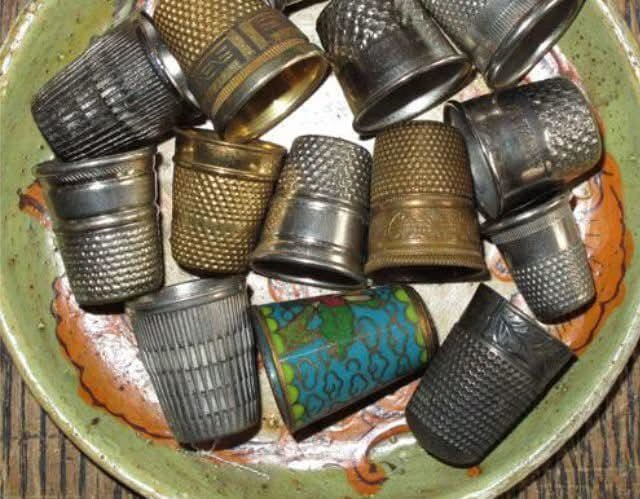Found These at My Grandma’s House: The Fascinating Journey of Thimbles
Discovering mysterious objects at your grandma’s house can feel like uncovering a small treasure chest filled with history and memories. Among such discoveries, one often overlooked but fascinating object is the thimble. These small tools have a surprisingly rich and intricate history. Though seemingly simple, thimbles have played an essential role in many cultures for centuries, evolving from practical sewing implements into beautiful and highly collectible items.
What Is a Thimble?
A thimble is a small protective device worn on the finger, typically used in sewing to push needles through fabric without injuring the fingertip. While it may appear ordinary at first glance, the thimble’s story spans thousands of years, multiple continents, and countless styles and materials. From bronze in ancient civilizations to finely crafted gold and silver versions in Europe, thimbles have been both functional and ornamental, reflecting the creativity and ingenuity of their makers.
Early Beginnings: From Bronze to Leather
The earliest known thimbles date back to ancient Pompeii in the 1st century AD. These early examples were usually made of bronze and were designed primarily for utility: to protect the sewer’s finger from the sharp point of a needle. Archaeological evidence shows that even in early times, people recognized the need for simple yet effective finger protection during sewing.
As centuries passed, thimbles began appearing in other cultures. In medieval Europe, they were often made from leather, wood, or iron. The designs were practical but also began to reflect the cultural artistry of their makers. Leather thimbles, for example, were lightweight and flexible, making them popular among travelers and artisans who needed mobility while working.
The Rise of Brass and European Craftsmanship
By the 14th century, Nuremberg, Germany, had become famous for producing high-quality brass thimbles. These thimbles were durable, uniform, and often featured intricate patterns created by skilled metalworkers. Nuremberg’s reputation helped establish the thimble not just as a sewing tool but as a symbol of craftsmanship and attention to detail.
In addition to their practical use, these thimbles began appearing as decorative items. The brass surface allowed for stamping, engraving, and even etching, creating a combination of beauty and utility. This period also saw the introduction of the “dimpled” surface—tiny indentations that made pushing a needle easier and prevented slipping.
Thimbles as Luxury Items
The 17th century saw thimbles evolve into luxury objects. Silver, gold, and even porcelain were used to craft exquisite thimbles that were often adorned with enamel, gemstones, and intricate engravings. These luxury thimbles were sometimes given as gifts or displayed as symbols of wealth and status.
During this era, thimbles also began to hold cultural significance beyond their practical function. In some European countries, ornate thimbles were collected as gifts during special occasions, weddings, or as tokens of affection. The tradition of collecting thimbles became an early form of memorabilia, highlighting the value people placed on craftsmanship and artistic expression.
Thimbles in Everyday Life
While thimbles often evoke images of luxury and art, they were fundamentally a practical tool used by artisans of all kinds. Beyond sewers, bookbinders, lacemakers, and leatherworkers all relied on thimbles to protect their fingers. Each trade had its own preferred material and design, and the thimble’s shape and texture were often tailored to the specific needs of the craft.
Thimbles also appear in popular culture. In the classic story of Peter Pan, a thimble symbolized a kiss, turning a small, everyday object into a token of affection. Thimbles even became game pieces in Monopoly, reflecting their long-standing familiarity and usefulness in daily life.
The Global History of Thimbles
Thimbles were not limited to Europe. In Asia, early thimbles were made from bone, ivory, and copper, often beautifully decorated with carvings or inlays. In China, for example, thimbles were sometimes embroidered with delicate patterns or decorated with lacquer, demonstrating the combination of practicality and artistry.
In the Middle East, artisans crafted thimbles from silver and brass, occasionally decorating them with intricate geometric designs and inscriptions. Across cultures, the thimble became a small but significant object, representing skill, protection, and creativity.
From Tools to Collectibles
Today, thimbles are often collected as precious items rather than used for sewing. Collectors, known as Thimblers, search for thimbles made of porcelain, silver, bone, or other materials. Many focus on a particular era, design, or material, creating specialized collections that highlight the evolution of thimble craftsmanship over time.
Some thimbles are so unique and historic that they are displayed in museums, such as the Fingerhut Museum in Germany, which houses thousands of distinctive thimbles from around the world. Each thimble tells a story, whether of its maker, its era, or its journey through generations of use and collection.
The Legacy of the Thimble
Although thimbles are no longer essential for most people’s daily sewing, they remain a symbol of craftsmanship, history, and creativity. Modern artists and artisans continue to create both classic and innovative designs, ensuring that the thimble’s legacy endures. They serve as a reminder of the human need to combine utility with artistry, turning even the smallest object into something meaningful.
Discovering a thimble in your grandma’s house is more than a simple find. It is a connection to centuries of history, cultural tradition, and human ingenuity. From ancient Pompeii to luxury European collections and contemporary art, the thimble stands as a testament to the enduring value of small, well-crafted objects.
Conclusion
Next time you see a small, unassuming thimble, remember that it is not just a tool—it is a piece of history. Whether used by artisans in workshops, given as a cherished gift, or collected as a decorative treasure, thimbles carry stories that span generations. These tiny objects remind us that even the smallest items can hold great significance, blending practicality, artistry, and cultural heritage in one remarkable package.







